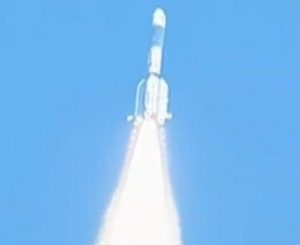 Indian Space Research Organisation (ISRO) on Wednesday successfully launched communication satellite GSAT-7A to boost the defense forces’ communication capabilities, particularly the Indian Air Force.
Indian Space Research Organisation (ISRO) on Wednesday successfully launched communication satellite GSAT-7A to boost the defense forces’ communication capabilities, particularly the Indian Air Force.
Geosynchronous Satellite Launch Vehicle GSLV-F11 carrying the GSAT-7A onboard lifted off the Second Launch Pad at SDSC at 04:10 pm as scheduled from the Second Launch Pad of Satish Dhawan Space Center in Andhra Pradesh’s Sriharikota.
In the next few days, scientists at MCF will perform various orbit-raising manoeuvres, using GSAT-7A’s onboard propulsion system, to place the satellite in its final geostationary orbit.
In his post-launch address, Chairman Dr K Sivan said, “the team has achieved another spectacular milestone by launching GSAT-7A.”
“In the last 35 days, ISRO has successfully launched three missions from SDSC starting with GSLV MkIII-D2 on November14, PSLV-C43 on November 29 and finally GSLV-F11 today. GSLV has successfully injected GSAT-7A into a super synchronous transfer orbit,” Dr Sivan said.
He said GSAT-7A is the heaviest satellite being launched by GSLV with an indigenously developed cryogenic stage.
“The cryogenic stage of this vehicle has been modified to increase the thrust rate. GSAT-7A is an advanced communication satellite with a Gregorian Antenna and many other new technologies. The testing and realisation of this satellite has been carried out meticulously by ISRO team. We have signed off year 2018 on a high and positive note,” Dr Sivan added.
According to the space agency, GSLV F11 is Isro’s fourth generation launch vehicle with three stages. The four liquid strap-ons and a solid rocket motor at the core form the first stage. The second stage is equipped with high thrust engine using liquid fuel. The Cryogenic Upper Stage forms the third and final stage of the vehicle.
GSAT-7A is the 39th Indian communication satellite of ISRO to provide services to the users in Ku-band over the Indian region. Most of the functional requirements of the communication payloads and the other systems have been derived from ISRO’s earlier geostationary INSAT/GSAT satellites.













